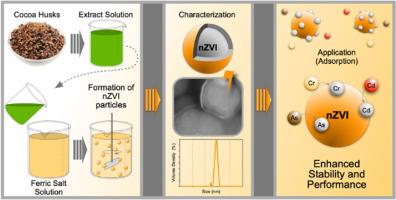重金属吸附合成零价铁纳米颗粒的绿色化学方法研究
IF 8.7
Q1 Environmental Science
引用次数: 0
摘要
随着人们对水中重金属污染的日益关注,有必要开发可持续和高效的处理方法。本研究比较了零价铁纳米颗粒(nZVI)去除镉、铬和砷的两种合成方法:使用硼氢化钠化学还原和使用可可壳提取物结合水热碳化(HTC)的绿色合成。化学合成的nZVI表现出很高的初始去除效率(98%),尽管随着时间的推移,由于颗粒老化,解吸效应会发生。相比之下,绿色合成的nZVI通过碳基质稳定,在酸性条件下保持120小时98%以上的稳定去除效率,表现出优异的稳定性和反应性。通过SEM、EDS和XRD表征,证实了Fe(0)芯层和氧化层促进金属的还原和吸附的双重去除机制。虽然每种合成方法的实验条件都得到了优化,但研究结果强调了绿色合成nZVI作为重金属修复的可持续替代方案的前景。未来的研究应探索吸附等温线和长期应用,以进一步验证这些材料的可扩展性和有效性。本文章由计算机程序翻译,如有差异,请以英文原文为准。

Examining green and chemical methods for zero-valent iron nanoparticle synthesis in heavy metal adsorption
The increasing concern over heavy metal contamination in water has necessitated the development of sustainable and efficient treatment methods. This study compares two synthesis approaches for zero-valent iron nanoparticles (nZVI) for cadmium, chromium, and arsenic removal: chemical reduction using sodium borohydride and green synthesis utilizing cocoa husk extracts combined with hydrothermal carbonization (HTC). Chemically synthesized nZVI exhibited high initial removal efficiencies (>98%), though desorption effects occurred over time due to particle aging. In contrast, green-synthesized nZVI, stabilized by a carbon matrix, maintained consistent removal efficiencies above 98% for 120 h under acidic conditions, showcasing superior stability and reactivity. Characterization through SEM, EDS, and XRD confirmed the dual mechanisms of metal removal: reduction and adsorption facilitated by the Fe(0) core and oxide layers. While experimental conditions were optimized for each synthesis method, the findings highlight the promise of green-synthesized nZVI as a sustainable alternative for heavy metal remediation. Future studies should explore adsorption isotherms and long-term applications to further validate the scalability and efficacy of these materials.
求助全文
通过发布文献求助,成功后即可免费获取论文全文。
去求助
来源期刊

Water Cycle
Engineering-Engineering (miscellaneous)
CiteScore
9.20
自引率
0.00%
发文量
20
审稿时长
45 days
 求助内容:
求助内容: 应助结果提醒方式:
应助结果提醒方式:


